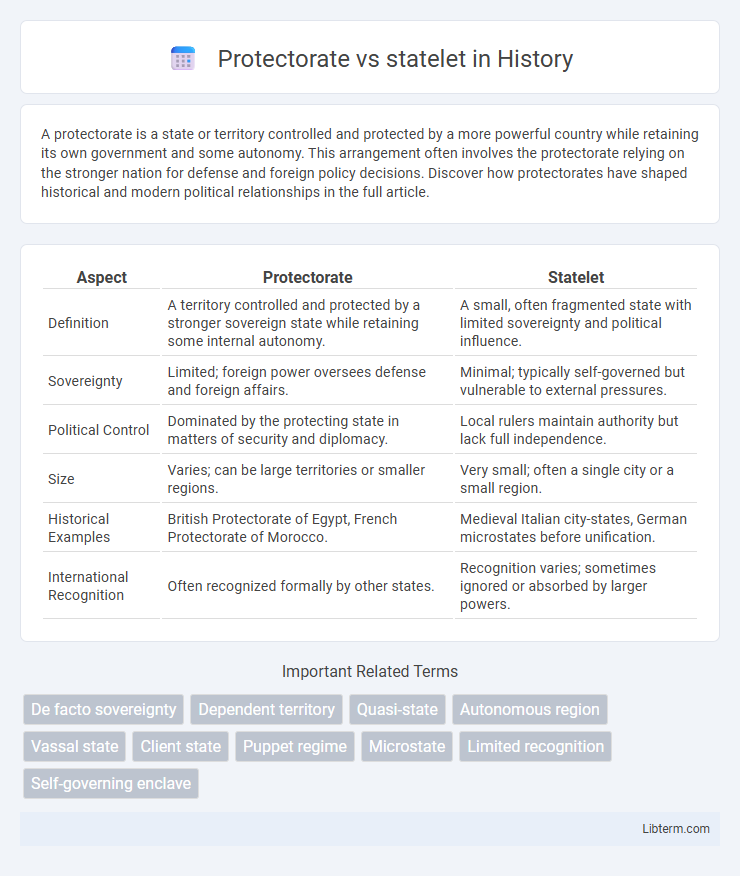A protectorate is a state or territory controlled and protected by a more powerful country while retaining its own government and some autonomy. This arrangement often involves the protectorate relying on the stronger nation for defense and foreign policy decisions. Discover how protectorates have shaped historical and modern political relationships in the full article.
Table of Comparison
| Aspect | Protectorate | Statelet |
|---|---|---|
| Definition | A territory controlled and protected by a stronger sovereign state while retaining some internal autonomy. | A small, often fragmented state with limited sovereignty and political influence. |
| Sovereignty | Limited; foreign power oversees defense and foreign affairs. | Minimal; typically self-governed but vulnerable to external pressures. |
| Political Control | Dominated by the protecting state in matters of security and diplomacy. | Local rulers maintain authority but lack full independence. |
| Size | Varies; can be large territories or smaller regions. | Very small; often a single city or a small region. |
| Historical Examples | British Protectorate of Egypt, French Protectorate of Morocco. | Medieval Italian city-states, German microstates before unification. |
| International Recognition | Often recognized formally by other states. | Recognition varies; sometimes ignored or absorbed by larger powers. |
Understanding Protectorates: Definition and Features
Protectorates are political entities where a weaker state maintains internal autonomy while ceding control of foreign affairs and defense to a stronger sovereign power. This arrangement enables the protectorate to benefit from military protection and diplomatic support without full integration into the protector's territory. Unlike independent statelets, protectorates lack complete sovereignty and rely heavily on the protecting state for international representation and security.
Statelets Explained: Characteristics and Structure
Statelets are small, semi-autonomous political entities characterized by limited territorial control and a loosely structured governance system. Unlike protectorates, which are subject to external domination or oversight by a stronger state, statelets maintain internal sovereignty but often lack extensive bureaucratic institutions. Their political structure typically features localized leadership, minimal military capacity, and reliance on traditional or tribal authority frameworks.
Historical Origins of Protectorates
Protectorates originated historically as territories controlled by a dominant power that allowed limited self-governance while maintaining foreign policy and defense authority. Unlike fully sovereign statelets, protectorates emerged during colonial and imperial expansions, serving as buffer zones or strategic holdings without full annexation. This distinction reflects the layered sovereignty characteristic of 19th and early 20th-century imperial governance.
The Emergence of Statelets in Modern Politics
The emergence of statelets in modern politics reflects small, semi-sovereign entities that maintain limited autonomy while often relying on larger powers for protection, distinguishing them from protectorates which explicitly depend on another state for defense and foreign relations. Statelets typically arise in regions with fragmented political authority, emphasizing localized governance and identity within broader geopolitical frameworks. This distinction highlights evolving forms of governance where micro-sovereignty coexists alongside international sovereignty dynamics, influencing diplomatic recognition and regional stability.
Legal Status: Protectorate vs Statelet
A protectorate maintains legal sovereignty under the authority of a more powerful state that controls its defense and foreign relations while allowing limited internal self-government. In contrast, a statelet operates as a small, often autonomous political entity with recognized sovereignty but typically lacks extensive international recognition and government infrastructure. Legal status of protectorates involves dependency and partial suzerainty, whereas statelets possess nominal independence with limited international legal standing.
Sovereignty and Autonomy Comparison
A protectorate retains limited sovereignty, as its foreign policy and defense are controlled by a stronger state, restricting full autonomy. Statelets, typically small and weak political entities, exercise limited sovereignty but often maintain greater internal self-governance than protectorates. The key distinction lies in protectorates' partial external control versus statelets' relative independence in internal affairs despite limited international recognition.
Governance Models and Administrative Control
Protectorates operate under a governance model where an external sovereign power retains significant control over foreign affairs and defense, while allowing limited internal administrative autonomy to the local rulers. Statelets function as small, semi-independent political entities with self-contained governance structures, maintaining full authority over their internal administration but lacking broad international recognition or influence. The administrative control in protectorates is characterized by a dual system, combining local leadership with overarching external supervision, contrasting with statelets' purely localized, self-governed management.
International Recognition and Diplomatic Relations
Protectorates often possess limited international recognition, relying on the suzerain state to manage their foreign affairs and diplomatic relations, which restricts their ability to independently engage in global diplomacy. Statelets, typically smaller and less formal political entities, usually lack widespread international recognition and maintain minimal or unofficial diplomatic contacts, hindering their participation in international organizations and treaties. Both protectorates and statelets face significant challenges in asserting sovereignty and achieving autonomous representation on the global stage due to their ambiguous or dependent political statuses.
Case Studies: Notable Protectorates and Statelets
The British Protectorate of Bahrain exemplifies a notable protectorate, where the island maintained internal autonomy while Britain controlled defense and foreign affairs. Conversely, Monaco serves as a prominent statelet, characterized by its small size, semi-independence, and sovereign rule under a constitutional monarchy. These cases highlight the distinctive sovereignty and administrative arrangements that separate protectorates from statelets.
Implications for Global Geopolitics
Protectorates often function under the military or political control of a more powerful state, limiting their sovereignty and influence in global geopolitics, whereas statelets typically possess greater autonomy but lack significant international recognition, restricting their diplomatic leverage. The strategic importance of protectorates can shift balance in international alliances, impacting regional stability and power dynamics. In contrast, statelets may foster localized conflicts or serve as geopolitical flashpoints due to ambiguous sovereignty and competing claims.
Protectorate Infographic

 libterm.com
libterm.com